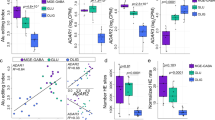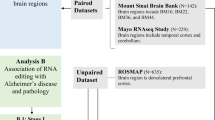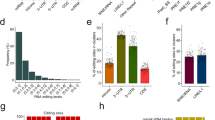Abstract
RNA editing critically regulates neurodevelopment and normal neuronal function. The global landscape of RNA editing was surveyed across 364 schizophrenia cases and 383 control postmortem brain samples from the CommonMind Consortium, comprising two regions: dorsolateral prefrontal cortex and anterior cingulate cortex. In schizophrenia, RNA editing sites in genes encoding AMPA-type glutamate receptors and postsynaptic density proteins were less edited, whereas those encoding translation initiation machinery were edited more. These sites replicate between brain regions, map to 3′-untranslated regions and intronic regions, share common sequence motifs and overlap with binding sites for RNA-binding proteins crucial for neurodevelopment. These findings cross-validate in hundreds of non-overlapping dorsolateral prefrontal cortex samples. Furthermore, ~30% of RNA editing sites associate with cis-regulatory variants (editing quantitative trait loci or edQTLs). Fine-mapping edQTLs with schizophrenia risk loci revealed co-localization of eleven edQTLs with six loci. The findings demonstrate widespread altered RNA editing in schizophrenia and its genetic regulation, and suggest a causal and mechanistic role of RNA editing in schizophrenia neuropathology.
This is a preview of subscription content, access via your institution
Access options
Access Nature and 54 other Nature Portfolio journals
Get Nature+, our best-value online-access subscription
$29.99 / 30 days
cancel any time
Subscribe to this journal
Receive 12 print issues and online access
$209.00 per year
only $17.42 per issue
Buy this article
- Purchase on Springer Link
- Instant access to full article PDF
Prices may be subject to local taxes which are calculated during checkout







Similar content being viewed by others
Data availability
The CMC investigators are committed to the release of data and analysis results, with the anticipation that data sharing in a rapid and transparent manner will speed the pace of research to the benefit of the greater research community. Data and analytical results generated through the CMC are available through the CMC Knowledge Portal: https://doi.org/10.7303/syn2759792.
Code availability
Code for identifying RNA editing sites and quantifying RNA editing ratios are provided in the public repository: https://github.com/BreenMS/RNAediting
Differential RNA editing, co-editing network analyses and edQTL analysis used standard software packages.
References
McGrath, J., Saha, S., Chant, D. & Welham, J. Schizophrenia: a concise overview of incidence, prevalence, and mortality. Epidemiol. Rev. 30, 67–76 (2008).
Owen, M., Sawa, A. & Mortensen, P. Schizophrenia. Lancet 388, 86–97 (2016).
Kirov, G. CNVs in neuropsychiatric disorders. Hum. Mol. Genet. 24, R45–R49 (2015).
Xu, B. et al. De novo gene mutations highlight patterns of genetic and neural complexity in schizophrenia. Nat. Genet. 44, 1365–1369 (2012).
Takata, A. et al. Loss-of-function variants in schizophrenia risk and SETD1A as a candidate susceptibility gene. Neuron 82, 773–780 (2014).
Ripke, S. et al. Biological insights from 108 schizophrenia-associated genetic loci. Nature 511, 421–427 (2014).
Fromer, M. et al. Gene expression elucidates functional impact of polygenic risk for schizophrenia. Nat. Neurosci. 19, 1442–1452 (2016).
Meier, S. M. et al. High loading of polygenic risk in cases with chronic schizophrenia. Mol. Psychiatry 21, 969–974 (2016).
Behm, M. & Öhman, M. RNA editing: a contributor to neuronal dynamics in the mammalian brain. Trends Genet. 32, 165–175 (2016).
Tan, M. et al. Dynamic landscape and regulation of RNA editing in mammals. Nature 550, 249–254 (2017).
Nishikura, K. A-to-I editing of coding and non-coding RNAs by ADARs. Nat. Rev. Mol. Cell Biol. 17, 83–96 (2016).
Rosenthal, J. J. & Seeburg, P. H. A-to-I RNA editing: effects on proteins key to neural excitability. Neuron 74, 432–439 (2012).
Rula, E. Y. et al. Developmental modulation of GABAA receptor function by RNA editing. J. Neurosci. 28, 6196–6201 (2008).
Krestel, H. E. et al. A genetic switch for epilepsy in adult mice. J. Neurosci. 24, 10568–10578 (2004).
Wahlstedt, H., Daniel, C., Ensterö, M. & Ohman, M. Large-scale mRNA sequencing determines global regulation of RNA editing during brain development. Genome Res. 19, 978–986 (2009).
Lyddon, R., Dwork, A. J., Keddache, M., Siever, L. J. & Dracheva, S. Serotonin 2c receptor RNA editing in major depression and suicide. World J. Biol. Psychiatry 14, 590–601 (2013).
Gaisler-Salomon, I. et al. Hippocampus-specific deficiency in RNA editing of GluA2 in Alzheimer’s disease. Neurobiol. Aging 35, 1785–1791 (2014).
Kwak, S. & Kawahara, Y. Deficient RNA editing of GluR2 and neuronal death in amyotropic lateral sclerosis. J. Mol. Med. 83, 110–120 (2005).
Herrick-Davis, K., Grinde, E. & Niswender, C. M. Serotonin 5‐HT2C receptor RNA editing alters receptor basal activity: implications for serotonergic signal transduction. J. Neurochem. 73, 1711–1717 (1999).
Marion, S., Weiner, D. M. & Caron, M. G. RNA editing induces variation in desensitization and trafficking of 5-hydroxytryptamine 2c receptor isoforms. J. Biol. Chem. 279, 2945–2954 (2004).
Sodhi, M. S., Burnet, P. W., Makoff, A. J., Kerwin, R. W. & Harrison, P. J. RNA editing of the 5-HT 2C receptor is reduced in schizophrenia. Mol. Psychiatry 6, 373–379 (2001).
Dracheva, S. et al. Increased serotonin 2C receptor mRNA editing: a possible risk factor for suicide. Mol. Psychiatry 13, 1001–1010 (2008).
Sommer, B., Köhler, M., Sprengel, R. & Seeburg, P. H. RNA editing in brain controls a determinant of ion flow in glutamate-gated channels. Cell 67, 11–19 (1991).
Kubota-Sakashita, M., Iwamoto, K., Bundo, M. & Kato, T. 1 A role of ADAR2 and RNA editing of glutamate receptors in mood disorders and schizophrenia. Mol. Brain 7, 5 (2014).
Lomeli, H. et al. Control of kinetic properties of AMPA receptor channels by nuclear RNA editing. Science 266, 1709–1713 (1994).
Morohashi, Y. et al. Molecular cloning and characterization of CALP/KChIP4, a novel EF-hand protein interacting with presenilin 2 and voltage-gated potassium channel subunit Kv4. J. Biol. Chem. 277, 14965–14975 (2002).
Kitagawa, H. et al. A regulatory circuit mediating convergence between Nurr1 transcriptional regulation and Wnt signaling. Mol. Cell Biol. 27, 7486–7496 (2007).
Sullivan, P. F. et al. Genomewide association for schizophrenia in the CATIE study: results of stage 1. Mol. Psychiatry 14, 1144 (2009).
Perroud, N. et al. Genome-wide association study of increasing suicidal ideation during antidepressant treatment in the GENDEP project. Pharm. J. 12, 68–88 (2012).
Weißflog, L. et al. KCNIP4 as a candidate gene for personality disorders and adult ADHD. Eur. Neuropsychopharmacol. 23, 436–447 (2013).
Ge, X., Frank, C. L., Calderon de Anda, F. & Tsai, L. H. Hook3 interacts with PCM1 to regulate pericentriolar material assembly and the timing of neurogenesis. Neuron 65, 191–203 (2010).
Mistry, M., Gillis, J. & Pavlidis, P. Genome-wide expression profiling of schizophrenia using a large combined cohort. Mol. Psychiatry 18, 215–225 (2013).
Irimia, M. et al. Evolutionarily conserved A-to-I editing increases protein stability of the alternative splicing factor Nova1. RNA Biol. 9, 12–21 (2012).
Murphy, F. V. 4th, Ramakrishnan, V., Malkiewicz, A. & Agris, P. F. The role of modifications in codon discrimination by tRNA Lys UUU. Nat. Struct. Mol. Biol. 11, 1186–1191 (2004).
Javitt, D. C. Glutamatergic theories of schizophrenia. Isr. J. Psychiatry Relat. Sci. 47, 4–16 (2010).
Ching, M. S. et al. Deletions of NRXN1 (neurexin‐1) predispose to a wide spectrum of developmental disorders. Am. J. Med. Genet. Part B: Neuropsychiatr. Genet. 153, 937–947 (2010).
Gauthier, J. et al. Truncating mutations in NRXN2 and NRXN1 in autism spectrum disorders and schizophrenia. Hum. Genet. 130, 563–573 (2011).
Kushima, I. et al. Resequencing and association analysis of the KALRN and EPHB1 genes and their contribution to schizophrenia susceptibility. Schizophr. Bull. 38, 552–560 (2010).
Glantz, L. A. & Lewis, D. A. Decreased dendritic spine density on prefrontal cortical pyramidal neurons in schizophrenia. Arch. Gen. Psychiatry 57, 65–73 (2000).
Massone, S. et al. RNA polymerase III drives alternative splicing of the potassium channel–interacting protein contributing to brain complexity and neurodegeneration. J. Cell Biol. 193, 851–866 (2011).
Shibata, R. et al. A fundamental role for KChIPs in determining the molecular properties and trafficking of Kv4. 2 potassium channels. J. Biol. Chem. 278, 36445–36454 (2003).
Marshall, C. R. et al. CNV and Schizophrenia Working Groups of the Psychiatric Genomics Consortium. Contribution of copy number variants to schizophrenia from a genome-wide study of 41,321 subjects. Nat. Genet. 49, 27–35 (2017).
C Yuen, R. K. et al. Whole genome sequencing resource identifies 18 new candidate genes for autism spectrum disorder. Nat. Neurosci. 20, 602–611 (2017).
Hjelm, B. E. et al. Evidence of mitochondrial dysfunction within the complex genetic etiology of schizophrenia. Mol. Neuropsychiatry 1, 201–219 (2015).
Ben-Shachar, D. & Laifenfeld, D. Mitochondria, synaptic plasticity, and schizophrenia. Int. Rev. Neurobiol. 59, 273–296 (2004).
Rodrigues, N. R. et al. Characterization of Ngef, a novel member of the Dbl family of genes expressed predominantly in the caudate nucleus. Genomics 65, 53–61 (2000).
Tinker, A., Qadeer, A. & Alison., T. The role of ATP‐sensitive potassium channels in cellular function and protection in the cardiovascular system. Br. J. Pharmacol. 171, 12–23 (2014).
Akrouh, A., Halcomb, S. E., Nichols, C. G. & Sala-Rabanal, M. Molecular biology of KATP channels and implications for health and disease. IUBMB Life 61, 971–978 (2009).
Dobin, A. et al. STAR: ultrafast universal RNA-seq aligner. Bioinformatics 29, 15–21 (2013).
Ramaswami, G. & Li, J. B. RADAR: a rigorously annotated database of A-to-I RNA editing. Nucleic Acids Res. 42, D109–D113 (2014).
Li, H. et al. The sequence alignment/map format and SAMtools. Bioinformatics 25, 2078–2079 (2009).
Buuren, S. V. & Groothuis-Oudshoorn, K. Mice: multivariate imputation by chained equations in R. J. Stat. Softw. 45, 1–68 (2010).
Lawrence, M., Gentleman, R. & Carey, V. rtracklayer: an R package for interfacing with genome browsers. Bioinformatics 25, 1841–1842 (2009).
Hoffman, G. E. & Schadt, E. E. variancePartition: interpreting drivers of variation in complex gene expression studies. BMC Bioinformatics 17, 483 (2016).
Ritchie, M. E. et al. Limma powers differential expression analyses for RNA-sequencing and microarray studies. Nucleic Acids Res. 43, e47–e47 (2015).
Friedman, J., Hastie, T. & Tibshirani, R. Regularization paths for generalized linear models via coordinate descent. J. Stat. Softw. 33, 1–22 (2010).
Robin, X. et al. pROC: an open-source package for R and S+ to analyze and compare ROC curves. BMC Bioinformatics 12, 12–77 (2011).
Bailey, T. L., Williams, N., Misleh, C. & Li, W. W. MEME: discovering and analyzing DNA and protein sequence motifs. Nucleic Acids Res. 34, W369–W373 (2006).
Paz, I., Kosti, I., Ares, M. Jr, Cline, M. & Mandel-Gutfreund, Y. RBPmap: a web server for mapping binding sites of RNA-binding proteins. Nucleic Acids Res. 42, W361–W367 (2014).
Langfelder, P. & Horvath, S. WGCNA: an R package for weighted correlation network analysis. BMC Bioinformatics 9, 559 (2008).
Chen, Jing et al. ToppGene Suite for gene list enrichment analysis and candidate gene prioritization. Nucleic Acids Res. 37, W305–W311 (2009).
Zeisel, A. et al. Cell types in the mouse cortex and hippocampus revealed by single-cell RNA-seq. Science 347, 1138–1142 (2015).
Shabalin, A. A. Matrix eQTL: ultra fast eQTL analysis via large matrix operations. Bioinformatics 28, 1353–1358 (2012).
Lizio, M. et al. Update of the FANTOM web resource: high resolution transcriptome of diverse cell types in mammals. Nucleic Acids Res. 4, D737–D743 (2016).
Gel, B. et al. Regioner: an R/Bioconductor package for the association analysis of genomic regions based on permutation tests. Bioinformatics 32, 289–291 (2015).
Dobbyn, A. et al. Landscape of conditional eQTL in dorsolateral prefrontal cortex and co-localization with schizophrenia GWAS. Am. J. Hum. Genet. 102, 1169–1184 (2018).
Acknowledgements
Data were generated as part of the CommonMind Consortium, supported by funding from Takeda Pharmaceuticals Company Ltd, F. Hoffman-La Roche Ltd and NIH grant nos. R01MH085542, R01MH093725, P50MH066392, P50MH080405, R01MH097276, R01-MH-075916, P50M096891, P50MH084053S1, R37MH057881, AG02219, AG05138, MH06692, R01MH110921, R01MH109677, R01MH109897 and U01MH103392, and contract no. HHSN271201300031C through the NIMH’s Intramural Research Program. Brain tissue for the study was obtained from the following brain bank collections: the Mount Sinai NIH Brain and Tissue Repository, the University of Pennsylvania Alzheimer’s Disease Core Center, the University of Pittsburgh NeuroBioBank and Brain and Tissue Repositories, and the NIMH HBCC. CMC leadership comprises: P. Roussos, J. D. Buxbaum, A. Chess, S. Akbarian, V. Haroutunian (Icahn School of Medicine at Mount Sinai), B. Devlin, D. Lewis (University of Pittsburgh), R. Gur, C.-G. Hahn (University of Pennsylvania), E. Domenici (University of Trento), M. A. Peters, S. Sieberts (Sage Bionetworks), T. Lehner, G. Senthil, S. Marenco and B. K. Lipska (NIMH). DLPFC RNA-seq data, which formed the basis of the validation cohort, were provided by the NIMH HBCC. Rhesus macaque tissue was provided by S. Hemby through the Stanley Medical Research Institute for Funding for Non-Human Primate Research, and funded by NIMH grant no. R01MH074313.
Author information
Authors and Affiliations
Consortia
Contributions
J.D.B., P.S., J.B.L. and M.S.B contributed to experimental design, study design and formulating the research question. J.D.B. and P.S. contributed to the funding of this work. M.S.B., A.D. and Q.L. contributed to data analysis. P.R., G.E.H., E.S., A.C, P.S., B.D. and J.D.B. contributed to leadership and supervision of various aspects of this work. M.S.B. and J.D.B. contributed to writing the manuscript, and all authors contributed in completing the final version.
Corresponding authors
Ethics declarations
Competing interests
The authors declare no competing interests.
Additional information
Peer review information: Nature Neuroscience thanks T. Kato, J. Yang and the other, anonymous, reviewer(s) for their contribution to the peer review of this work.
Publisher’s note: Springer Nature remains neutral with regard to jurisdictional claims in published maps and institutional affiliations.
Supplementary information
Supplementary Table 1
Description of RNA editing events.
Supplementary Table 2
Overlap of RNA editing events across brain regions and cohorts.
Supplementary Table 3
Motif enrichment analysis.
Supplementary Table 4
RBP enrichment analysis.
Supplementary Table 5
Genes enriched for differential RNA editing sites.
Supplementary Table 6
Overlap of co-editing models across brain regions and cohorts.
Supplementary Table 7
Co-localization analysis (coloc2) using 108 SCZ GWAS loci.
Rights and permissions
About this article
Cite this article
Breen, M.S., Dobbyn, A., Li, Q. et al. Global landscape and genetic regulation of RNA editing in cortical samples from individuals with schizophrenia. Nat Neurosci 22, 1402–1412 (2019). https://doi.org/10.1038/s41593-019-0463-7
Received:
Accepted:
Published:
Issue Date:
DOI: https://doi.org/10.1038/s41593-019-0463-7
This article is cited by
-
Transcriptomic analysis reveals associations of blood-based A-to-I editing with Parkinson’s disease
Journal of Neurology (2024)
-
Changes in ADAR RNA editing patterns in CMV and ZIKV congenital infections
BMC Genomics (2023)
-
Precision RNA base editing with engineered and endogenous effectors
Nature Biotechnology (2023)
-
Advances in brain epitranscriptomics research and translational opportunities
Molecular Psychiatry (2023)
-
A game changer for bipolar disorder diagnosis using RNA editing-based biomarkers
Translational Psychiatry (2022)



